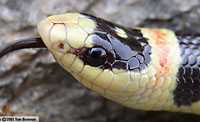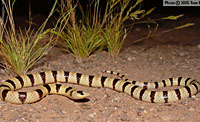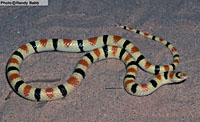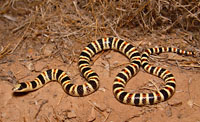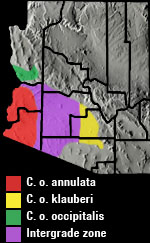Online Field Guide to The Reptiles and Amphibians of Arizona


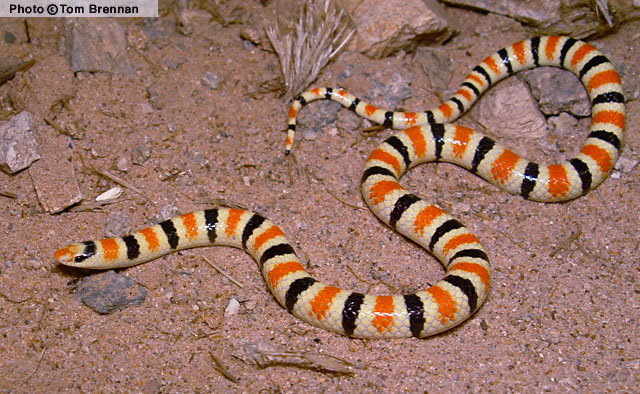
Yuma County, AZ
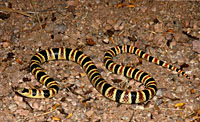 Pinal Co., AZ |
||
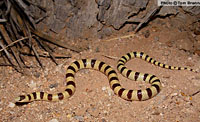 Mohave Co., AZ |
| WESTERN SHOVEL-NOSED SNAKE Chionactis occipitalis |
Mildly Toxic Saliva
|
| DESCRIPTION: A small (up to 369 mm or 15″ in total length) snake with more than 20 dark brown to black bands on a cream to light yellow background. Some subspecies have secondary orange saddles between the black bands (see subspecies descriptions below). The orange saddles are separated from the black by a margin of cream to light yellow background color. The posterior black bands usually completely encircle the body but the anterior bands do not. The snout is cream or light yellow. A black mask crosses the top of the head and covers the eyes. The underside is cream. With its countersunk jaw, valves in the nasal passages, concaved belly, and relatively flat snout, this snake is well equipped for burrowing under fine sand and loose gravel. The pupils are round and the scales are smooth and shiny. The Western Shovel-nosed Snake’s light snout distinguishes it from the similar looking Sonoran Coralsnake which has a black snout. The similar Sonoran Shovel-nosed Snake has fewer than 21 black body bands.
DISTRIBUTION: This snake is found in the low deserts of western and south-central Arizona at elevations ranging from near sea level to ca. 2,500′. Populations in the eastern portion of this snake’s range appear to be in decline. Populations near Tucson and Paradise Valley have been extirpated. HABITAT: Lower Colorado River Sonoran Desertscrub and Mohave Desertscrub communities are home to this snake. It is usually found in or near sandy washes or dunes in desert flats or on gently sloping bajadas. DIET: The Western Shovel-nosed Snake feeds on a variety of invertebrates including insects, spiders, centipedes, and scorpions. It may occasionally eat reptile eggs. REPRODUCTION: Mating takes place in spring and a clutch of up to 9 eggs is laid in the summer. By Thomas C. Brennan Brennan, T. C., and A. T. Holycross. 2006. A Field Guide to Amphibians and Reptiles in Arizona. Arizona Game and Fish Department. Phoenix, AZ Brennan, T. C., and A. T. Holycross. 2005. A Field Guide to Amphibians and Reptiles of Maricopa County. Arizona Game and Fish Department. Phoenix, AZ Fowlie. 1965. The Snakes of Arizona. Azul Quinta Press, Fallbrook, California Lowe, Schwalbe, Johnson. 1986. The Venomous Reptiles of Arizona. Nongame Branch Stebbins. 1985. Western Reptiles and Amphibians. Houghton Mifflin. New York, NY |
|
Visit Partners in Amphibian and Reptile Conservation:


HOME
Copyright © 2023, Arizona Game and Fish Department. All rights reserved.
If you make use of the textual contents of this site in reports, publications, etc. please cite and credit the author(s) and photographer(s). All photos on this website are copyrighted. However, those found in the species account section may be used for any noncommercial scientific, educational, or conservation purposes provided that photographs are not altered and continue to bear the copyright symbol and name of the photographer. Please contact the photographer regarding commercial use of copyrighted photographs.










